PHOTOPHILE- Lost city: County's biggest Monacan town emerges
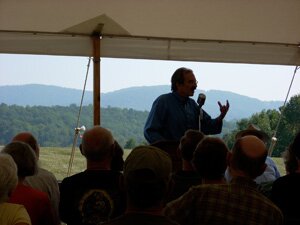
Monacans probably numbered as many as 50,000 in Virginia, said Hantman, noting that arrowheads collected from the West Virginia border to Loudoun to Richmond to Altavista suggest that the Monacans have at least a 12,000-year Virginia history.PHOTO BY HAWES SPENCER
It was such a notable town that Captain John Smith– although he never ventured this far inland– put it on his famous 1612 map of Virginia. Today, however, Albemarle's biggest Jamestown-era Indian village is just a memory, some hills and floodplain around the Rivanna River off Polo Grounds Road.
But the memory came alive on Sunday, September 23, for 150 or so listeners to the on-site talk by UVA's Jeffrey Hantman, an expert on Monacan Indians and this town called Monasukapanough. (Its exact pronunciation being unknown, Hantman and others were pronouncing it MON-ah-SOOK-ah-pa-NAW.)
Hantman suggests that residents of the village, which disappeared before Albemarle was settled in the early 1700s, hunted, fished, and probably grew corn, squash, and beans and might never have encountered the English colonists. One thing's for sure: they buried the bones of their dead in a mound.
That last factoid comes from Thomas Jefferson, who as a boy saw a passing Indian party take a six-mile detour to make a sorrowful pilgrimage to the mound. In 1783, Jefferson went to the site to conduct what Hantman calls a "scientific archaeological excavation." By then, the land was under cultivation by white settlers whose agricultural practices had trimmed the 40-foot diameter burial mound from 12 feet in height to just seven and a half.
Still, the approximately 1,000 sets of bones, none damaged by warfare, were enough to convince Jefferson that it was, as he wrote in his Notes on the State of Virginia, "the common sepulchre of a town."
After the talk, limeade and brownies were served, and at least two dozen attendees took a hike down the Rivanna River to get a sense of what might have been downtown Monasukapanough.
Part of the village lands are now the SOCA-ACAC South Fork Soccer Park, and part is the Bentivar subdivision. So where, someone asked, was the village?
"It could be here, and it could be down in the bottomlands," Hantman answered. "But it's probably all the way around us, the way the Monacans lived."
Please install Flash® and turn on Javascript.
FOR NON-FLASH BROWSERS, HERE'S HOW THINGS LOOKED:
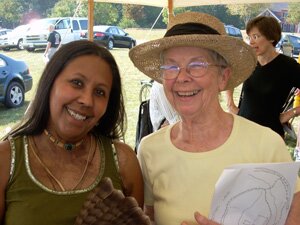
Victoria Ferguson, a Monacan and interpreter at the Natural Bridge Monacan village, and Jimmie Lou Reid, a member of the Proffit community since 1952
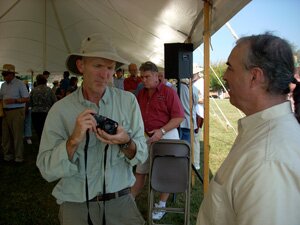
Bill Emory photographed Kenneth Branham, the chief of the Monacan nation, who was reelected to his fourth four-year term in July. "No Virginia Indian," Branham said, "would get upset being called 'Indian'."
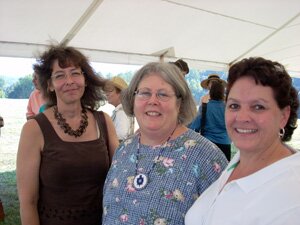
Karenne Wood, tribal council member; Judy Branham, the chief's wife; and Edith Durie, the chief's sister
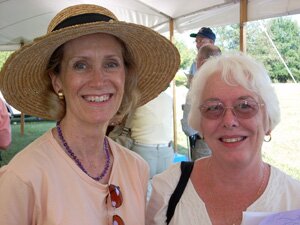
Clara Belle Wheeler, who owns the farm of pioneer George Rogers Clark, visits with Waynesboran Cathy Lang.
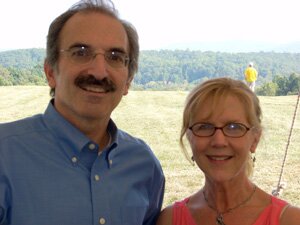
Jeffrey Hantman and Susan Lebeis, a Martha Jefferson nurse with a degree in anthropology
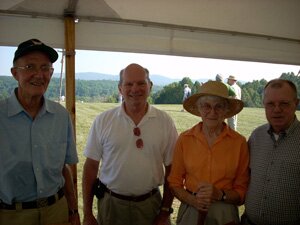
Nearby landowners Jim Murray, Don Swofford, and Bess Murray visit with Doug Clark, who began his 45-year aviation career from a grass strip on this bottomland, which his grandfather bought about 100 years ago.
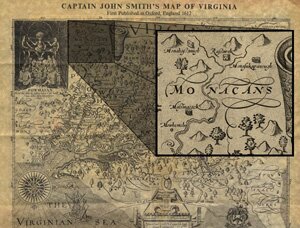
Captain John Smith's 1612 map shows Monasukapanough.
VIRGINIA CENTER FOR DIGITAL HISTORY
#
4 comments
Great article-Wish I could have been there. I live nearby in Carrsbrook. Who hosted this event? Is there text I would be able to post on our neighborhood site? www.Carrsbrook229901.org
Thank you
www.Carrsbrook22901.org is the correct address.
I knew it !!!!When the area was still all woods, with the exception of our home at 1430 Old Brook Rd. in Charlottesville, I often walked in our
2 1/2 acres behind the house. I was certain that the diamond shaped stony pieces I found were Indian arrowheads. And now this article confirms it. We moved there in 1974. I am glad that the assistant to the head of the medical dept.( a position my late husband had held) sent me your article. Thanks.
The Albemarle Charlottesville Historical Society (of which Hawes Spencer of the Hook is a former board member) hosted the event as its 3rd quarterly meeting (free to the public). Next one is at Emmanuel Episcopal Church in Greenwood on Nov. 11, to be followed by tours of local lumber yards (this is in conjunction with the Society's current exhibit on trees and related lumber industries in Albemarle County).
See www.albemarlehistory.org.